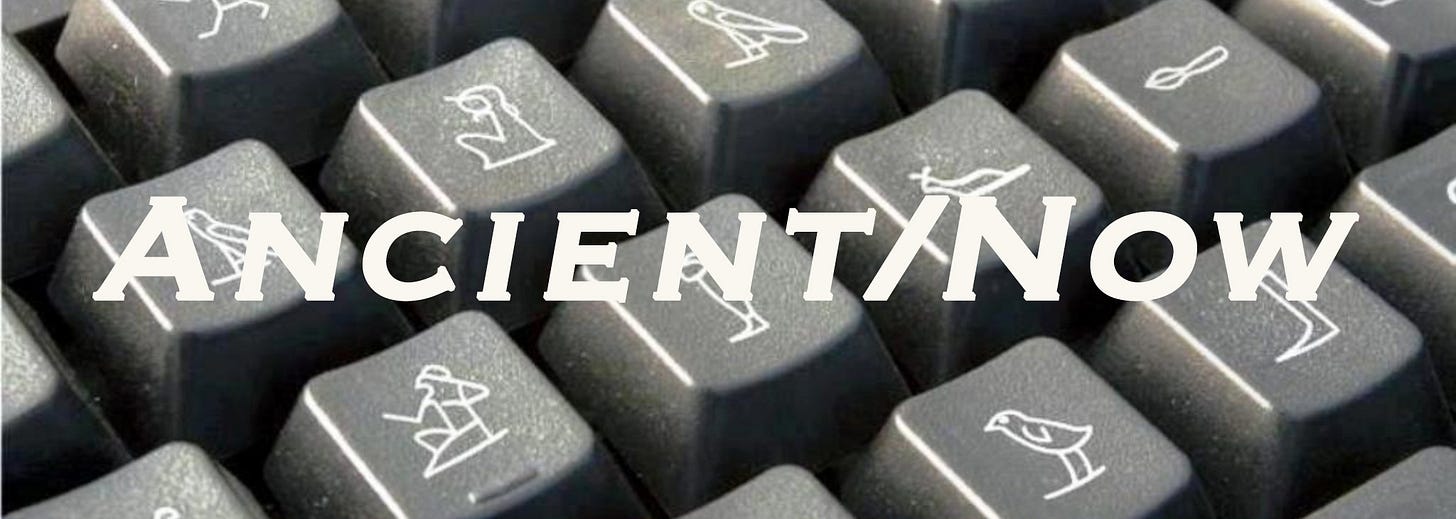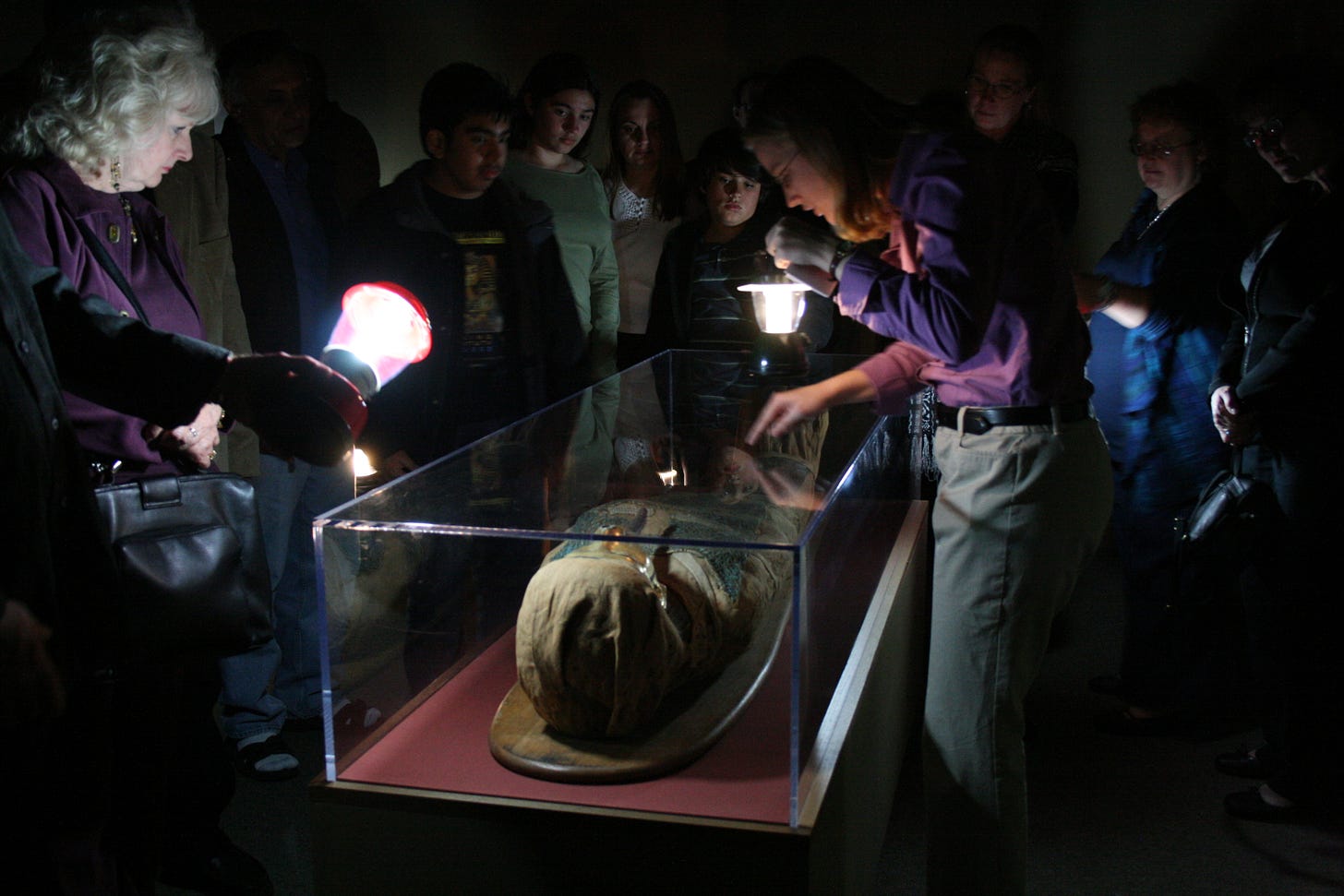Ancient/Now - February 10th
More discoveries at Wadi el-Jarf, museums avoid saying "mummy," the archaeological puzzle of a child's burial, and more
More discoveries at Wadi el-Jarf

Papyrus is old. Really old. And somehow it can survive 4,500 years. A recent article in New Lines Magazine highlights the latest discoveries at Wadi el-Jarf and reports on some of the evidence found there by Egyptologist Pierre Tallet (Université Paris-Sorbonne) and his team of archaeologists. In 2013 Tallet discovered entire rolls of papyri at Wadi el-Jarf written by some ship captains who had participated in the building the Great Pyramid of Khufu at Giza during the 4th Dynasty. Being the oldest papyri discovered in Egypt, they are some of the only bureaucratic records (i.e. not the normal propagandizing, everything-is-super-awesome, ideological text preserved on stone) we have from that period dealing with the construction of Khufu’s pyramid. Well, it’s been a decade after that papyrus discovery, and excavations at Wadi el-Jarf are ongoing and the archaeological evidence uncovered there continues to improve our understanding of ancient Egypt and the Old Kingdom in particular. Check it out, because who would have thought we would learn all about how the Giza pyramids were built from some boat captains who ended up out at the Red Sea and wanted to clean out there gear and left those old papyri for archaeologist to find almost 5000 years later…?
Don’t say “mummy”
Some museums in Britain are dispensing with the word “mummy” in referring to mummified remains, using terms like “mummified person” instead. One of the reasons given by a museum mentioned in this article for the change of wording is that some visitors did not realize they were looking at the remains of a real person, perfectly illustrating the way in which displaying mummies in a museum context can distance us from their humanity. Having given countless tours in museums displaying mummies, we can attest that this is a common misconception with some museum visitors.
The fact that issues like the display of mummified remains and the ongoing repercussions of the West’s colonial past and piracy of antiquities is on the radar of British museums is a sign of progress, but changing the language on gallery labels is literally the least we can do. The answer to this question of if, when, and how to display ancient human remains will continue to be a gray area for museums. When done with thoughtfulness and sensitivity, display of dead humans can be a way for people to learn about the past and feel the connection of our common humanity despite the centuries that separate us. Although British museums frame this change in terminology as a way to more accurately describe an exhibit of a mummy and highlight that viewers are confronting the remains of a once-living person, it is ultimately a way to concede that we are still displaying human remains without taking them off exhibition and without truly grappling with the issue.
Child buried with 142 dogs provides more questions than answers
Archaeologists working at the site of an ancient necropolis in Egypt’s Fayum region have uncovered an archaeological puzzle: an 8-year-old child buried with 142 dogs, which, we must say, zoologist Galina Belova concluded all perished at the same time but with no evidence of violence (whaaaa?). Some evidence suggests the dogs may have drowned in a flood, explaining their simultaneous, non-violent deaths. Maybe the child swept away in the flood too, while caring for the dogs…but this was a formal burial, so what is going on? Adding to the mystery, the child was buried with a linen bag over their head (remember, bioarchaeologists can’t easily gender male or female children!). This detail becomes even more confusing alongside the fact that there is another burial at the necropolis in which the deceased had the same type of linen bag over his head. In the case of this adult burial, however, maybe we have a lead, because there was an arrow in the chest, leaving no doubt as to a violent cause of death. So was this an execution, perhaps? Or did violent deaths demand that certain dead be somehow contained with the linen bag? Burials at the site range in date from the 4th century BCE to the 7th century CE (Christian period in Egypt!), but the article is unclear as to the date of either of these burials. It would be interesting to see if further analysis yields other evidence that could lead to an explanation for these usual burials.
Museum’s “replica” 3,000-year-old sword turns out to be real

Nearly a century ago the Field Museum acquired what it believed to be a well-made replica of a 3,000-year-old Bronze Age sword recovered from the Danube River in Budapest, Hungary (because who doesn’t want one of those?). The “replica” remained in the museum’s collection until recently when curators began preparing for the First Kings of Europe special exhibition. It was during this preparation that Hungarian archaeologists and the museum’s scientists got a better look at the sword and decided to analyze it with technology that didn’t exist back in the 1930’s when the sword was thought to be nothing more than a replica.
The group of Field Museum scientists, including a chemist, and archeologists used an X-ray fluorescence detector, an instrument that looks like a ray gun. When they compared the sword’s chemical makeup to other known Bronze Age swords in Europe, their content of bronze, copper, and tin were nearly identical.
We all wish we owned this unknown treasure. But this kind of thing happens in museums more often than you think. In 1992 the J. Paul Getty Museum acquired a marble bust of the Roman Emperor Commodus (for reference, that’s the Emperor Joaquin Phoenix played in the 2000 movie The Gladiator) that the museum initially identified as an 16th century copy of a lost Roman original. Years later, when Getty conservators conducted a scientific analysis of the bust, they identified it as dating to the reign of Commodus (180–192 CE). (Read more here about the story of “The Getty Commodus.”) True, the Getty Museum is not your attic, but one can always hope…
But don’t get cocky! The re-examination of artifacts in museums can go the other way when experts reveal an artifact once thought to be genuine as a fake. (Bummer! And read about the Getty Kouros here, but that’s still up for debate.) Never forget that as knowledge and technologies improve, it’s worthwhile for museums to periodically re-analyze the artifacts in their collections because there may be objects in their storerooms with more secrets to reveal. Technologies are always improving….
Archaeology Abridged with Kara Cooney - “Ramses the Great: Power and Patriarchy”
Last month Kara gave her lecture “Ramses the Great: Power and Patriarchy” for the Archaeological Institute of America’s Archaeology Abridged series. It was a short twenty-minute lecture followed by a Q&A session with the audience—you can watch it now on YouTube!








